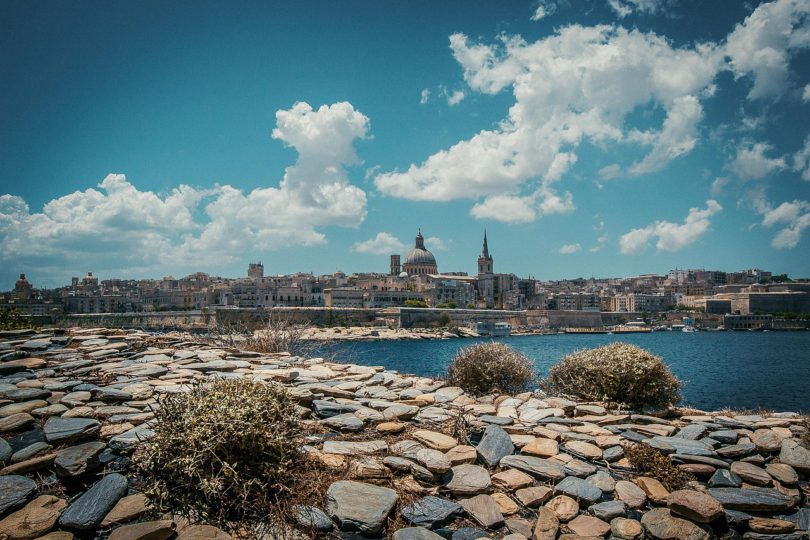From the moment you step through Valletta’s City Gate, Malta’s capital begins to reveal its story in layers. The sweeping 16th-century bastion walls curve around the harbor, a reminder of the city’s military past. Just inside, the elegant sweep of Corinthian columns and the crisp geometry of Art Deco details mix seamlessly with the post-war Triton Fountain, which anchors the entrance plaza. And beyond, Baroque church domes crown the skyline, rising above some of the world’s oldest temples—megalithic sites dating back nearly 6,000 years.
This is Malta in miniature: a crossroads of civilizations, marked by centuries of conquests and cultural exchange.
A Crossroads of Empires
Over the centuries, Malta’s position in the center of the Mediterranean attracted Phoenicians, Carthaginians, Romans, French, and later the British, who ruled from 1813 until independence in 1964. Each left their mark, creating a cultural and architectural patchwork still visible today. UNESCO recognized Valletta as a World Heritage Site in 1980, calling it “one of the most concentrated historic areas in the world.” In just 136 acres, the city squeezes in roughly 320 monuments—churches, palaces, fortresses, and piazzas—all within walking distance.
Unlike many busy Mediterranean ports, Valletta maintains a sense of calm. Its grid layout, designed by the Knights of St. John after they fortified the city in 1530, gives it order and elegance, a legacy of the Crusader era.
The Fifth City Gate
Valletta’s current City Gate represents both continuity and reinvention. The gateway is the fifth iteration in the city’s history, redesigned in 2014 by the Renzo Piano Building Workshop. Instead of competing with the historic fortifications, the project emphasized simplicity—drawing attention to the limestone ramparts and opening up views of the old city. The redesign wasn’t just cosmetic; it symbolized Malta’s ability to respect its past while embracing progress.
Culture in Motion
That balance between history and innovation is also central to MICAS—the Malta International Contemporary Arts Space—just a short walk from the City Gate. “Valletta is ancient but open to innovation,” notes Guillaume Dreyfuss, MICAS’s director.
Housed in an 18th-century hospice, the museum is itself a piece of history: the site originally sheltered pilgrims nearly a thousand years ago. Today, its restored tunnels and hidden staircases connect with sleek skybridges designed by Florence-based Ipostudio, creating a striking backdrop for contemporary art. International works, such as Joana Vasconcelos’s colorful knit tree and Ugo Rondinone’s bluestone sculptures, share space with Maltese artists, sparking dialogue between global trends and local creativity.
A Taste of the Mediterranean
Malta’s Mediterranean identity is perhaps most clearly expressed in its cuisine. In recent years, the island’s chefs have been pushing boundaries while staying rooted in local traditions.
At Ion Harbour, Malta’s first restaurant to earn two Michelin stars, the menu celebrates the sea: dishes such as rossi prawn paired with delicate sea jelly highlight local flavors with modern technique. At Le GV, set in the art-deco inspired 1926 Le Soleil Hotel, the kitchen plays with contrasts—think amberjack served with a pink-grapefruit zabaglione made from local fruit. Both showcase the island’s growing reputation as a culinary destination.
Modern Malta: Innovation on the Horizon
What makes Malta unique among Mediterranean islands is its status as a small yet independent nation. That autonomy allows for swift development in infrastructure and policy.
In 2024, the island launched KM Malta Airlines, modernizing its aviation sector. The Sliema ferry terminal underwent a major upgrade, improving connections across the archipelago, while new cruise links from Valletta now reach Sicily and other nearby destinations.
At the same time, Malta is making bold moves toward sustainability. Plans are underway to phase out gas-powered cars by 2030, and the government is installing electric charging stations for cruise ships—expected to cut port emissions by up to 90%. These initiatives reflect a vision of Malta as both a heritage destination and a forward-looking hub for responsible tourism.
Valletta Today
Walking through Valletta is like traveling through time. Megalithic ruins whisper of prehistory, Baroque cathedrals recall the power of the Knights, and sleek cultural venues point to a dynamic future. Yet the city never feels chaotic; instead, it holds together with an elegance born of centuries of adaptation.
For travelers, this means a destination that offers both timeless beauty and modern vitality. You can explore ancient temples in the morning, enjoy cutting-edge art installations in the afternoon, and finish the day with a meal that bridges tradition and innovation. Valletta is more than a historic capital—it’s a living city that continues to evolve while honoring its roots.

